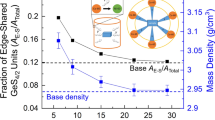Abstract
Metallic multilayers are good model systems to explore the effects of heterophase interfaces in reducing radiation damage in structural materials. We summarize recent studies on radiation damage in immiscible face-centered cubic/body-centered cubic metallic multilayers, in particular Cu/V and Cu/Nb. These multilayers have shown unique characteristics compared to bulk metals under irradiation, including several orders of magnitude higher He solid solubility, dramatic reduction of bubble density, interface confined growth of He bubbles, and much lower radiation hardening. The mechanisms for interface enhanced radiation tolerance are briefly discussed.
Similar content being viewed by others
References
R.E. Stoller and G.R. Odette, ASTM Special Technical Publications, 782 (1982), p. 275.
A.A. Lucas, Physica B & C, 127 (1984), p. 225.
H. Trinkaus and B.N. Singh, J. Nucl. Matls., 323 (2003), p. 229.
J. Laakmann, P. Jung, and W. Uelhoff, Acta Metallurgica, 35 (1987), p. 2063.
H. Landolt, P. Ehrhart, and H. Ullmaier, Atomic Defects in Metals (Berlin: Springer-Verlag, 1991).
G.W. Greenwood, A.J.E. Foreman, and D.E. Rimmer, J. Nucl. Matls., 1 (1959), p. 305.
R.J. Kurtz, F. Gao, H.L. Heinisch, B.D. Wirth, G.R. Odette, and T. Yamamoto, “Atomistic Modeling of He Binding and Migration at Interfaces in Fe” (paper presented at the TMS 2005 Annual Meeting, San Francisco, California, February 13–17, 2005).
W.G. Wolfer, J. Nucl. Matls., 93/94 (1980), p. 713.
D.L. Porter, G.D. Hudman, and F.A. Garner, J. Nuclear Materials, 179–181 (March–April 1991), pt. A, pp. 581–584.
D.L. Porter and F.A. Garner, J. Nucl. Matls., 159 (1988), pp. 114–121.
B.N. Singh, Phil. Mag., 28(6) (1973), pp. 1409–1413.
N. Li, M.S. Martin, O. Anderoglu, A. Misra, L. Shao, H. Wang, and X. Zhang, J. Appl. Phys., 105 (2009), p. 12.
N. Li, E.G. Fu, H. Wang, J.J. Carter, L. Shao, S.A. Maloy, A. Misra, and X. Zhang, J. Nucl. Matls., 389 (2009), p. 233.
E.G. Fu, J. Carter, G. Swadener, A. Misra, L. Shao, H. Wang, and X. Zhang, J. Nucl. Matls., 385 (2009), p. 629.
T. Hochbauer, A. Misra, K. Hattar, and R.G. Hoagland, J. Applied Physics, 98 (2005), 123516.
X. Zhang, N. Li, O. Anderoglu, H. Wang, J.G. Swadener, T. Hochbauer, A. Misra, and R.G. Hoagland, Nuclear Instruments & Methods in Physics Research Section B-Beam Interactions with Materials and Atoms, 261(1–2) (2007), p. 1129.
A. Misra, M.J. Demkowicz, X. Zhang, and R.G. Hoagland, JOM, 59(9) (2007), p. 62.
M. Ruhle and M. Wilkens, Crystal Lattice Defects, 6 (1975), pp. 129–140.
Z.M.D. Ziegler and J.F. Biersack, “Calculation using the Stopping and Range of Ions in Matter (SRIM) Code, http://www.srim.org/.
M.J. Demkowicz, R.G. Hoagland, and J.P. Hirth, Physical Review Letters, 100 (2008). 136102.
B. Xian-Ming, A.F. Voter, R.G. Hoagland, M. Nastasi, and B.P. Uberuaga, Science, 327 (2010), p. 1631.
E.G. Fu, A. Misra, H. Wang, and X. Zhang, “Interface Enabled Defects Reduction in Helium Ion Irradiated Cu/V Nanolayers,” J. Nucl. Matls. (in press), doi:10.1016/j.jnucmat.2010.10.011.
M.J. Demkowicz, D. Bhattacharyya, I. Usov, W.Q. Wang, M. Nastasi, and A. Misra, APL, 97 (2010), 161903.
T.E. Mitchell, Y.C. Lu, A.J. Griffin, M. Nastasi, and H. Kung, J. American Ceramic Society, 80 (1997), p. 1673.
M.J. Demkowicz and R.G. Hoagland, Int. J. Applied Mechanics, 1 (2009, p. 421.
M.J. Demkowicz, J. Wang, and R.G. Hoagland, in Dislocations in Solids, Vol. 14, ed. J.P. Hirth (Amsterdam: Elsevier, 2008), p. 141.
R. Lasser, K. Bickmann, H. Trinkhaus, and H. Wenzl, Phys. Rev. B, 34 (1986), p. 4364.
H. Pfeiffer and H. Peisl, Phys. Lett., 60 (1977), p. 363.
W.G. Wolfer, Phil. Mag. A, 59 (1989), p. 87.
J. Friedel, Dislocations (New York: Pergamon, 1964).
F. Kroupa and P.B. Hirsch, Disc. Faraday Soc., 38 (1964), p. 49.
S.J. Zinkle and Y. Matsukawa, J. Nucl. Matls., 329 (2004), p. 88.
Author information
Authors and Affiliations
Corresponding author
Rights and permissions
About this article
Cite this article
Zhang, X., Fu, E.G., Misra, A. et al. Interface-enabled defect reduction in He ion irradiated metallic multilayers. JOM 62, 75–78 (2010). https://doi.org/10.1007/s11837-010-0185-5
Published:
Issue Date:
DOI: https://doi.org/10.1007/s11837-010-0185-5




